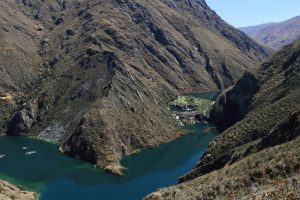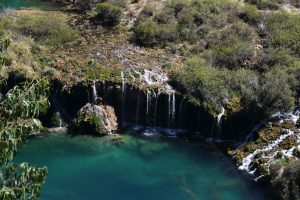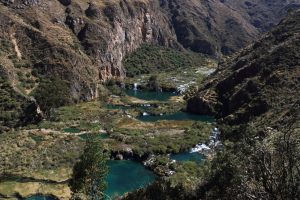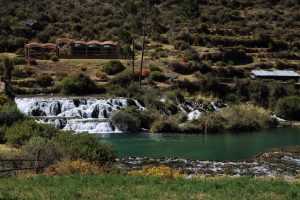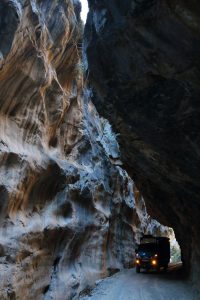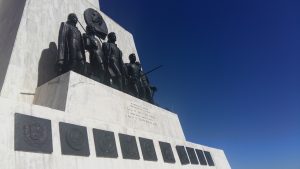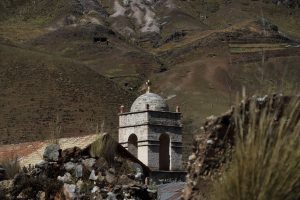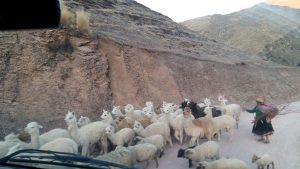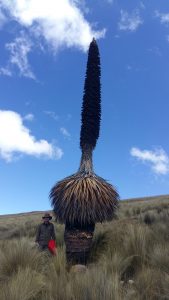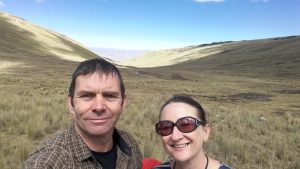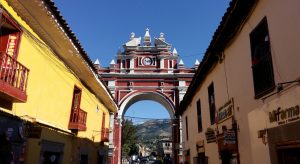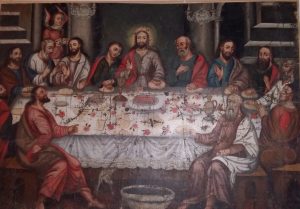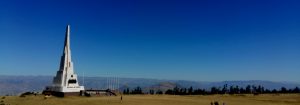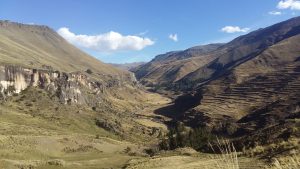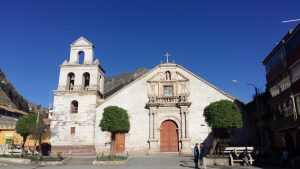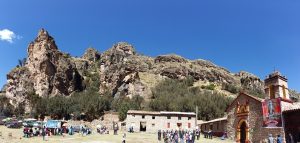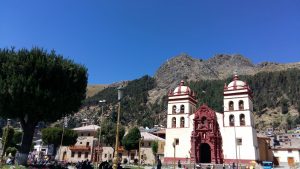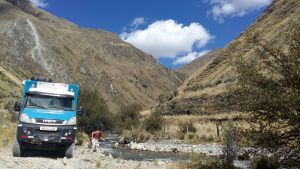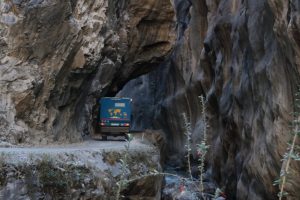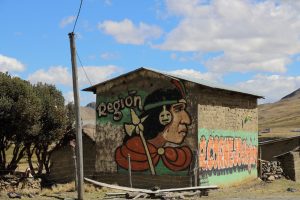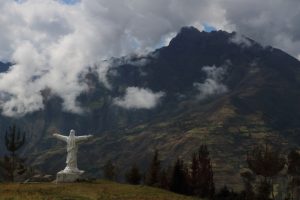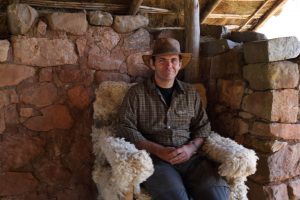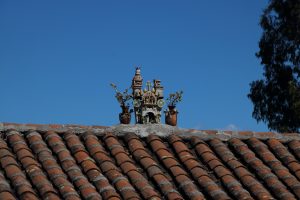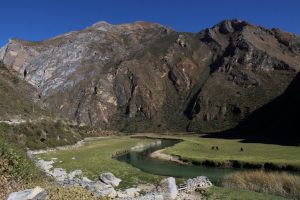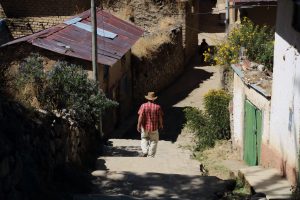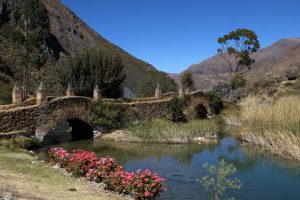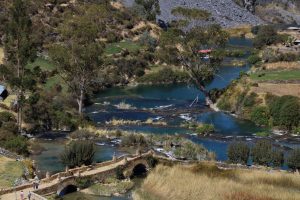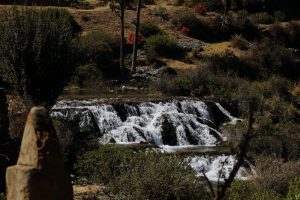So is it all Incas and llamas in Peru? Well, okay… there are quite a lot of Inca sites and there are quite a few wandering llamas. But there’s other stuff too…. Honest! For our third entry to Peru, we crossed the Brazilian Amazon into the (rather similar looking) south Peruvian Amazon. Now we head up to the Andes, Peru’s central highlands, for a long-awaited dose of cool, crisp mountain air. On the way we see battlefields, industrial heritage, some lakey-scenery and just the odd llama by an Inca ruin!

The Cusco Battle
First stop is the mega-tourist centre of Cusco. Keen Cuthbert fans may recall we came here last year: visited Machu Picchu, hiked to Rainbow Mountain and climbed a 400m via-ferrata to sleep in a glass pod hanging off the cliff-face! This time we just want to rest and acclimatise to the altitude at around 3,400m/11,100ft. Yes, I know, Cusco isn’t everyone’s cup-of-tea, but I have to admit to rather liking the place. Despite the obviously dominant tourism industry, I think it still retains an air of authenticity. I love the huge, varied market where locals lunching on their roasted cuy (guinea pig) blend seamlessly with gap-year kids buying knitted alpaca hats.
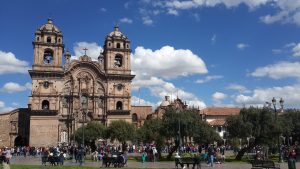
Back in lovely Cusco
Quinta Lala is the overlanders’ camp of choice in Cusco. Almost every overlander in the region seems to end up here, so you’re sure to meet like-minded travel-bods. This time we meet again with Swiss traveller Marc who we last met over a year ago in Salta, Argentina. Over a camp-fire we have a pleasant time catching up with Marc, his wife Barbara and others at the camp. After a few days of socialising and acclimatising we’re ready to move on. We say our goodbyes and set-off to explore deepest-darkest Peru… or so we thought!
Unfortunately, the Peruvian National Union of Teachers (or some similarly-named august organisation) has different plans for us and blockades our route out of Cusco. On the outskirts of town, crowds are gathering with lots of police with riot gear. The atmosphere is tense but peaceful. Okay… we know when we’re beaten… we take the police advice and head back to Quinta Lala for a bit more acclimatising and socialising. We’re lucky, we have time to spare. But it’s not so rosy for many other tourists in Cusco this week.
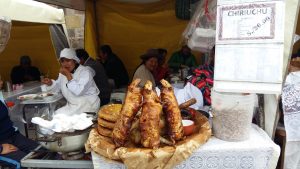
Cuy asado (roast guinea pigs) Cusco Market
The route we plan to take to Ayacucho just happens to be the same route that leads to Machu Picchu. The protesters are blocking not only the road, but the tourist train-line down the Sacred Valley. These Peruvian teachers know how to make a point! Many unhappy tourists on their trip-of-a-lifetime to see the celebrated Inca hot-spot are now sitting in Cusco biding time to catch their flight home without so much as a glimpse of the place 🙁
Next day, the police tell us there will be a ‘window’ in the afternoon when we will be able to pass. Around 15:00 hrs we try again to leave the town… Success! We’re on our way to Ayacucho. We read in the news that the mayhem continues the next day and also that the Government is introducing a ‘State of Emergency’ in the region. This makes the protests illegal and gives the police powers to deal with any attempts at disrupting tourists. At the same time, there are threats for the protest to ‘go national’, so this may not be the last we hear from the Peruvian teachers as we head north.
Ayacucho – a different kind of battle
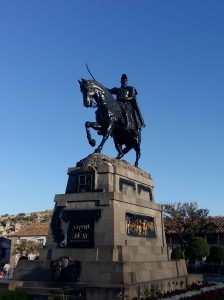
The ubiquitous Sucre – this time in Ayacucho
If you wander any distance around Hispanic South America you are sure to have regular encounters with chaps such as: San Martín, Sucre and Bolívar. Their statues feature in countless town-squares across the continent and they feature in names of many streets, plazas, cities and, in Simon Bolívar’s case, even a country. These are the military top-brass who, after 44 years of fighting, successfully sent the Spanish occupiers packing, back to Madrid with their tails between their legs. Their years of struggle culminated near in Ayacucho, in December 1824. After losing the battle to General Sucre, the Spanish General de Canterac finally ‘threw in the towel’ right here. It’s a moving location and of great significance to all the Hispanic nations of the continent; it’s where their futures as independent nations were sealed and they have jointly erected a stunning monument on the battlefield hill-top.
Other than the battlefield, Ayacucho is a pleasant stop and definitely worth a place on your ‘Peru things to do’ list. It’s smaller and far less touristy than Cusco, but it has museums (where incidentally, the delicacy of roast guinea-pig is so popular it features on the plate of Jesus in a local interpretation of the famous ‘Last Supper’ masterpiece!), churches and quaint little streets with markets, shops and restaurants. And at a mere 2,700m/8,800ft, it’s lower than Cusco. Which brings me to on to the subject of ‘altitude’.
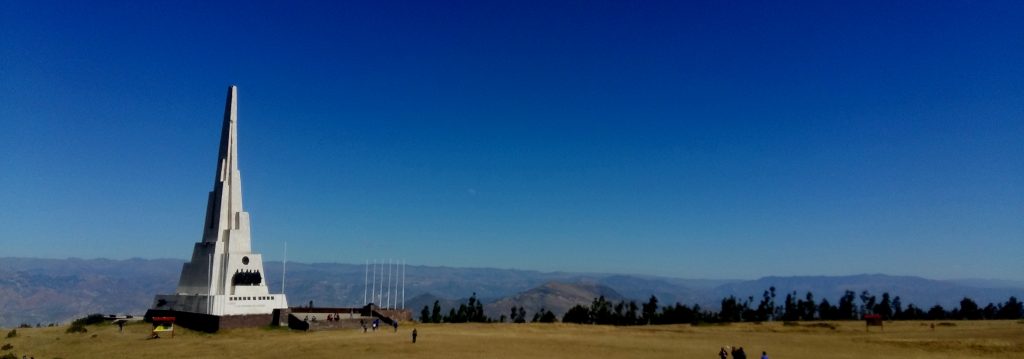
Altitude Palaver
For the last few months we’ve been at/around sea-level. Suddenly, we’re up high in the Andes. Some years ago, we used to think that a ski-week in Val D’Isere (1,800m/6,000ft) was coping with altitude. Ha! How little we knew! Himalayas aside (still on our ‘to do’ list), you ‘ain’t seen nuthin’ till you’ve done the high Andes and Altiplano of Bolivia/Peru! Spending time around 4,000m and above tends to give your physiology the wobbles. Here’s our (less than scientific) findings…
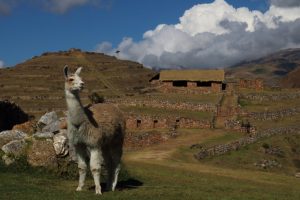
It’s Peru… you’ve got to do a bit of llama and Inca stuff!
First, insomnia – so hard to sleep up there. Then there’s alcohol intolerance – tragically, even a small beer can cause upset stomach. There’s also desiccation – the air is so dry that it makes eye-balls, throat and nostrils uncomfortable. Fierce sun – thin air means you burn in minutes if not protected. Lack of appetite – well, one of us loses weight up here, but sadly it’s not me 🙁 And finally… exploding bottles – tops blow off bottles. The biggest disaster is our precious squeezy-bottle of Branston Pickle dispersing itself around the interior of the fridge. And I struggle comically to stop oozing sun-cream and moisturiser gushing out of the tubes under pressure, covering my hands, the bathroom surfaces and anything else in the vicinity!
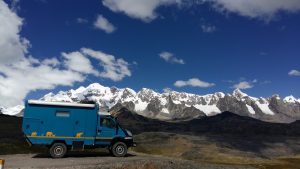 Generally, we get used to the altitiude after a bit of acclimatisation. But we’re always relieved if we can descend into a valley below 3,000m/10,000ft for a better chance at sleeping!
Generally, we get used to the altitiude after a bit of acclimatisation. But we’re always relieved if we can descend into a valley below 3,000m/10,000ft for a better chance at sleeping!
So if that’s the ‘pain’, what’s the gain? Well… the photos of the views are the primary evidence of the reward. The scenery, the hiking, the raw and rare nature. The interesting villages, towns, churches, markets and people. And there’s the bright, dazzling, deep blue skies. It’s just a beautiful and fascinating environment. We love it up here. If only we could just sip a glass of plonk in the evening and get a good night’s sleep 🙂
Yauyas-Cochas
Andean Peru isn’t short on natural beauty. We’ve travelled the length of the country twice now; believe me… there’s plenty to go around! But this time we were pleased to find another stunning area: the Reserva Nor Yauyas-Cochas. A bit of a mouthful, but really worth a visit. It’s full of emerald green lakes, crystal-clear streams, breath-takingly narrow canyons, plus a couple of cutesie little villages in there too. What’s more to say? A picture paints a thousand words (more pics in the full gallery at the bottom):
- 1 Yauyas-Cochas
- 2 Yauyas-Cochas
- 3 Yauyas-Cochas
- 4 Yauyas-Cochas
- 5 Yauyas-Cochas
Mines
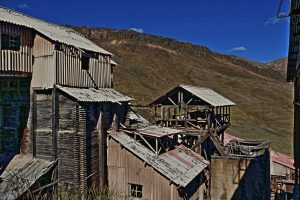
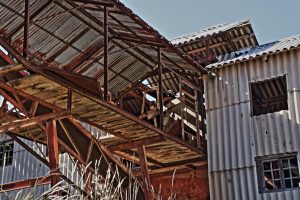 Peru’s main source of income depends on mining its natural resources, and it has done so for many years. The main routes from the high Andes down to the coastal ports are constantly clogged with crawling mega-mining-trucks. Despite the considerable national income from the industry, the mining communities are amongst the poorest and the unhealthiest in Peru. La Oroya is a classic example of this, featuring regularly on the ‘World’s most polluted’ lists. The mining scars the landscape, the contamination is harmful to health (particularly to children), the workers are poorly paid and their domestic water is rationed so that supplies can be diverted to the industries. Hmmm… that’s one side of modern Peru. But we also visit a mining site of the not-so-modern Peru.
Peru’s main source of income depends on mining its natural resources, and it has done so for many years. The main routes from the high Andes down to the coastal ports are constantly clogged with crawling mega-mining-trucks. Despite the considerable national income from the industry, the mining communities are amongst the poorest and the unhealthiest in Peru. La Oroya is a classic example of this, featuring regularly on the ‘World’s most polluted’ lists. The mining scars the landscape, the contamination is harmful to health (particularly to children), the workers are poorly paid and their domestic water is rationed so that supplies can be diverted to the industries. Hmmm… that’s one side of modern Peru. But we also visit a mining site of the not-so-modern Peru.
At over 4,200m in the mountains above Huancavelica sits the old Santa Barbara mineral mine. It’s hey-day was back in the 1700s, but it continued reduced operations until the 1970s. It’s not a ‘designated’ attraction – indeed attempts have been made to fence it off from public access – but it’s visited by the occasional curious passer-by. Clinging precariously to the steep mountainside, it has a strange, stark beauty to it.
The fences have fallen in many places, so we scramble through to have a look around this fascinating relic. An old, toothless chap approaches us with his herd of llamas. He has lived on the hillside all his life and used to work in the mercury section of the mine. We offer him a cup of our Yorkshire Tea (which he politely declares to be delicious!) and he tells tales of the mine’s history. There was once an attempt at restoration for posterity, but a party of students came up from the city and smashed the place up in a drunken brawl! That was the end of that 🙁
Anyway…. moving on. After three weeks up-high, in just a few hours we descend from over 4,800m down to 10m into central Lima-on-Sea! A glass of wine, a good nights’ sleep and some perfect croissants from the French bakery in Miraflores for breakfast 🙂
Link to next blog: Far-west with Whales Link to full South America Blog
Peru Central Highlands Photos
- Heroes of Ayacucho
- Santa Barbara
- Llama traffic hazard
- 6 Yauyas-Cochas
- The rare Puyo raimondii
- Ayacucho
- Spot the guinea-pig feast!
- Ayacucho battlefield
- Huancavelica
- Sacsamarca
- Huancavelica
- Filling the water-tank – all 230 litres
- 7 Yauyas-Cochas
- Hello my people!
- On the Inca Throne
- 4 Yauyas-Cochas
- The ubiquitous Sucre – this time in Ayacucho
- Cuy asado (roast guinea pigs)
- It’s Peru… you’ve got to squeeze in a bit of llama and Inca stuff!
- Back in lovely Cusco
- Roof-top blessing
- 5 Yauyas-Cochas
- 8 Yauyas-Cochas
- 9 Yauyas-Cochas
- 10 Yauyas-Cochas
- 11 Yauyas-Cochas
- 3 Yauyas-Cochas
- 2 Yauyas-Cochas
- 1 Yauyas-Cochas

